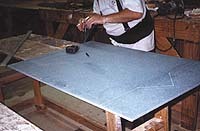Long-time sandblaster, monument builder here....
The only substrates suitable for sandblasting will be either glass, or stone such as marble or granite . There are no other thin substrates that will engrave to the depth you require. Plastics are ductile and will not produce more than a slight surface etch. The substrate must be friable (able to be fractured) in order to use sandblasting effectively. This is why soft rubber and vinyl stencil is so favorable for masking off
signs and stone monuments.
In the 2021 Matthews Architectural Products catalog, they have some samples of glass ADA signage with braille on page 80. They do some very cool things that anybody else could do if they have the knowledge of using photo-resist and the sandcarving process. The domed braille dots are integral to the single piece of glass. This is accomplished by etching the area around the dots to near-depth, then removing the mask to round off the top edges by further sandcarving. I did a sample piece of braille on glass a few years ago, and it really does work. Fine abrasive produces a satin finish, while coarser abrasive produces a rougher texture.
Check out Rayzist or Ikonics for sandcarving systems and photo-resist. Both offer complete process systems and training. Personally, I favor Ikonics due to their extensive product lineup of materials and equipment.
I've posted the attached photos before, and they have nothing to do with the subject at hand. But they're are an example of how sandcarving can be used to create a fine reverse etch (raised image).
These were done using
sign vinyl for sand mask. And while
sign vinyl might work well for your lettering, you're going to have a difficult time keeping the braille dots from moving while weeding the vinyl.
JB








